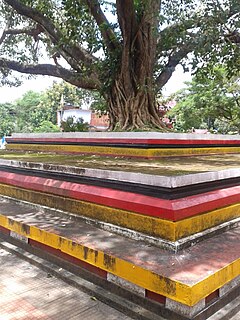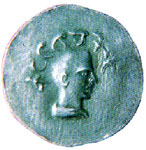Related Research Articles

The Tamil Sangams or Cankams were assemblies of Tamil scholars and poets that, according to traditional Tamil accounts, occurred in the remote past. Scholars believe that these assemblies were originally known as kooṭam or "gathering," which was also a name for Madurai. Three assemblies are described. The legend has it that the first two were held in cities since "taken by the sea", and the third was held in the present-day city of Madurai.

Cilappatikāram, also referred to as Silappathikaram or Silappatikaram, is the earliest Tamil epic. It is a poem of 5,730 lines in almost entirely akaval (aciriyam) meter. The epic is a tragic love story of an ordinary couple, Kannaki and her husband Kovalan. The Silappathikaram has more ancient roots in the Tamil bardic tradition, as Kannaki and other characters of the story are mentioned or alluded to in the Sangam literature such as in the Naṟṟiṇai and later texts such as the Kovalam Katai. It is attributed to a prince-turned-monk Iḷaṅkõ Aṭikaḷ, and was probably composed about 5th- or 6th-century CE.
Nedum Cheralathan was a Chera ruler of the early historic south India, contemporary to the Chola ruler Perunarkilli. He is the second known Chera ruler from the early Tamil literature, and is praised in the Second Ten of Pathitruppaththu.
The Five Great Epics are five large narrative Tamil epics according to later Tamil literary tradition. They are Cilappatikāram, Manimekalai, Cīvaka Cintāmaṇi, Valayapathi and Kuṇṭalakēci. The first mention of the Aimperumkappiyam occurs in Mayilainathar's commentary of Nannūl. However, Mayilainathar does not mention their titles. The titles are first mentioned in the late 18th–early 19th century work Thiruthanikaiula. Earlier works like the 17th century poem Tamil vidu thoothu mention the great epics as Panchkavyams. Among these, the last two, Valayapathi and Kuṇṭalakēci are not extant.

Kongu Nadu is a region comprising the western part of Tamil Nadu. In the ancient Tamilakam, it was the seat of the Chera kings, bounded on the east by Tondai Nadu, on the south-east by Chola Nadu and on the south by Pandya Nadu regions.

Ilango Adigal is traditionally credited as the author of Silappatikaram, one of the Five Great Epics of Tamil literature. In a patikam (prologue) to the epic poem, he identifies himself as the brother of a famous Chera king Ceṅkuṭṭuvan (Senguttuvan). This Chera king, states Elizabeth Rosen, ruled over his kingdom in late 2nd or early 3rd century CE. However, this is doubful because a Sangam poem in Patiṟṟuppattu – the fifth ten – provides a biography of Ceṅkuṭṭuvan, his family and rule, but never mentions that he had a brother who became an ascetic or wrote one of the most cherished epics. This has led scholars to conclude that the legendary author Ilango Adikal myth was likely inserted later into the epic. In a 1968 note, Kamil Zvelebil suggested that, "this [Adigal claim] may be a bit of poetic fantasy, practised perhaps by a later member of the Chera Dynasty [5th or 6th century] recalling earlier events [2nd or 3rd century]".

The Chera dynasty was one of the principal lineages in the early history of the present day states of Kerala and Tamil Nadu in southern India. Together with the Cholas of Uraiyur and the Pandyas of Madurai, the early Cheras were known as one of the three major powers (muventar) of ancient Tamilakam in the early centuries of the Common Era.
The Purananuru, sometimes called Puram or Purappattu, is a classical Tamil poetic work and traditionally the last of the Eight Anthologies (Ettuthokai) in the Sangam literature. It is a collection of 400 heroic poems about kings, wars and public life, of which two are lost and a few have survived into the modern age in fragments. The collected poems were composed by 157 poets, of which 14 are anonymous and at least 10 were poetess. This anthology has been variously dated between 1st-century BCE and 5th-century CE, with Kamil Zvelebil – a Tamil literature scholar, dating predominantly all of the poems of Purananuru sometime between 2nd- and 5th-century CE.

Sangam Period, or Sangam Age, is a now abandoned label for the period in history when the so-called "Sangam poems" were composed in south India. The term is currently considered as a misnomer. The term Sangam is currently used only as a label for denoting the earliest available Tamil literature, without implying a "Sangam Period".
Malaiyamān Thirumudi Kāri was one of the kings of the Kongu Tamil royal house clan of the Malaiyamān dynasty. He is one of Kadai ezhu vallal, literally the last seven patrons of art and literature. The Malaiyamān chiefs ruled over the Tirukoyilur area also known as Kovalur. it was ruled by kovalar kings.It was a strategically important region located on southern the banks of the Pennar river and en route from west coast to the east coast via Arikamedu in ancient Tamilakkam. They traced their lineage to the ancient Chedi Kingdom mentioned in the Kurukshetra war Thirumudi Kari rose to become a powerful emperor in Tamilakkam before he was killed by the early Chola king Killivalavan.
Patiṟṟuppattu is a classical Tamil poetic work and one of the Eight Anthologies (Ettuthokai) in the Sangam literature. It is a panegyric collection that exclusively contains puram category of Sangam poems.

Pazhayangadi, is a small township, approximately 22 kilometers north of district headquarters Kannur, 15 kilometers south of Payyanur and 14 kilometers west of Taliparamba in the South Indian state of Kerala. In the local language of Malayalam it literally means "Old Market". The town is bounded by the Madayi Hills (Madayippara) on the west and by the Pazhayangadi River on the south. Ezhimala, a range of hills, that is believed to be home to a variety of medical herbs including mrithasanjeevini, and a very ancient recorded history, is situated nearly 8 km west of Pazhayangadi. Pazhayangadi town is spread over Madayi and Ezhome Panchayaths. Madayi Hill offers a splendid scene of Ezhimala which means a chain of seven mountains, where the Indian Naval Academy is situated.
Gajabahu I, also known as Gajabahuka Gamani, was a Sinhalese king of Rajarata in Sri Lanka. He is renowned for his religious benefactions, extensive involvement in south Indian politics, and for possibly introducing the cult of the goddess Pattini to Sri Lanka. The primary source for his reign is the Mahavamsa, though he is also the only early Sri Lankan king to be extensively mentioned in the Chera Cilappatikaram.

The region of Tamil Nadu or Tamilakam, in the southeast of modern India, shows evidence of having had continuous human habitation from 15,000 BCE to 10,000 BCE. Throughout its history, spanning the early Upper Paleolithic age to modern times, this region has coexisted with various external cultures.
Ciṟupāṇāṟṟuppaṭai is an ancient Tamil poem, likely the last composed in the Pattuppattu anthology of the Sangam literature. It contains 296 lines in the akaval meter. It is one of five arruppatai genre poems and was a guide to other bards seeking a patron for their art. The main hero honored in the poem is Nalliyakkotan, but the poem reverentially mentions an additional seven minor chieftains and three kings. The poem is dated to sometime between the late 3rd-century and 5th-century by Kamil Zvelebil – a Tamil literature scholar.
Gajabahu synchronism is the chronological device used by historians to help date early Tamil history. The synchronism, first propounded by V. Kanakasabhai Pillai in 1904 in his The Tamils Eighteen Hundred Years ago, was adopted by some scholars of the time to date Tamil literature. Kamil Zvelebil, even while acknowledging the fragility of the synchronism, called it the "sheet anchor" of the dating of Tamil literature. The synchronism however, involves numerous conjectures and has been dismissed by Gananath Obeyesekere in his The Cult of the Goddess Pattini (1984) as ahistorical and invalid.

There are literary, archaeological, epigraphic and numismatic sources of ancient Tamil history. The foremost among these sources is the Sangam literature, generally dated to 5th century BCE to 3rd century CE. The poems in Sangam literature contain vivid descriptions of the different aspects of life and society in Tamilakam during this age; scholars agree that, for the most part, these are reliable accounts. Greek and Roman literature, around the dawn of the Christian era, give details of the maritime trade between Tamilakam and the Roman empire, including the names and locations of many ports on both coasts of the Tamil country.

Karur was built on the banks of River Amaravathi which was called Aanporunai during the Sangam days. The names of the early Chera kings who ruled from Karur, have been found in the rock inscriptions in Aru Nattar Malai close to Karur. The Tamil epic Silapathikaram mentions that the famous Chera King Senguttuvan ruled from Karur. In 150 AD Greek scholar Ptolemy mentioned Korevora (Karur) as a very famous inland trading center in Tamil Nadu.
Paranar was a poet of the Sangam period, to whom 84 verses of the Sangam literature have been attributed, besides verse 6 of the Tiruvalluva Maalai.

Kuttuvan Kotai, also spelled Kothai/Kodai, was a Chera ruler of early historic (pre-Pallava) south India.
References
- 1 2 3 Subbarayalu, Y. 2014. 'Early Tamil Polity', in A Concise History of South India: Issues and Interpretations. ed. Noburu Karashima, pp. 50–51. New Delhi: Oxford University Press.
- 1 2 K.G. Sesha Aiyar, Chera Kings of the Sangam Period, London, 1937. 21-23.
- 1 2 3 "Classical Indo-Roman Trade". Economic and Political Weekly. 48 (26–27). 5 June 2015.
- 1 2 Zvelebil, Kamil. ''The Smile of Murugan: On Tamil Literature of South India''. Leiden: E. J. Brill, 1973. 52–53.
- 1 2 3 4 K.G. Sesha Aiyar, Chera Kings of the Sangam Period, London, 1937. 21-23.
- 1 2 K.G. Sesha Aiyar, Chera Kings of the Sangam Period, London, 1937. 21-23.
- 1 2 Menon 1967.
- 1 2 Menon 2007, pp. 67–68.
- 1 2 3 4 5 6 Shulman, David (2016). Tamil: A Biography. Cambridge, Massachusetts: The Belknap Press of Harvard University Press. pp. 99–101.
- ↑ Menon, A Sreedhara. Kerala History and its Makers.
- ↑ K.G. Sesha Aiyar, Chera Kings of the Sangam Period, London, 1937. 21-23.
- 1 2 3 4 5 6 7 Zvelebil, Kamil V., Companion Studies to the History of Tamil Literature, Leiden, 1992. 110-111.
- 1 2 3 4 5 "Silappathikaram | Tamil epic poem by Adikal". Encyclopedia Britannica. Retrieved 4 February 2020.
- ↑ "Silappathikaram | Tamil epic poem by Adikal". Encyclopedia Britannica. Retrieved 16 November 2018.
- ↑ Zvelebil 1973, pp. 37–39: The opinion that the Gajabahu Synchronism is an expression of genuine historical tradition is accepted by most scholars today
- ↑ Zvelebil 1973, p. 38.
| This biography of a member of an Indian royal house is a stub. You can help Wikipedia by expanding it. |
| This Indian history-related article is a stub. You can help Wikipedia by expanding it. |